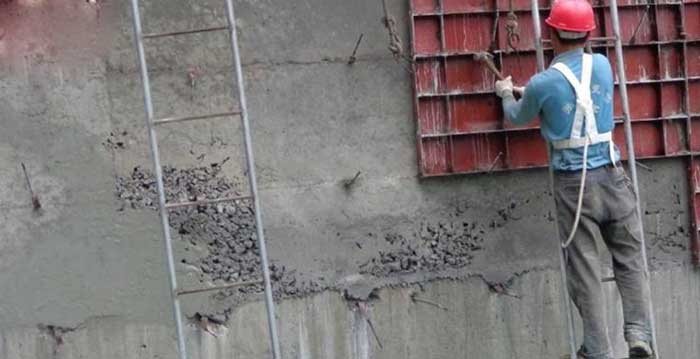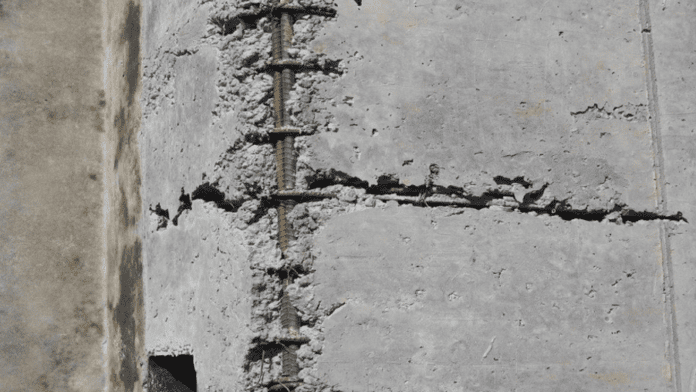Honeycomb refers to the hollow spaces and cavities on the concrete surface or inside the concrete mass. These are formed due to the presence of air bubbles or voids because concrete could not fill the spaces around coarse aggregate particles and reinforcing steel. It resembles a honey bee nest. It is visible once the formwork is removed. They occur across footings, walls, columns, beams, slabs, etc.
Honeycomb impacts the overall durability of the concrete and makes the reinforcements vulnerable. It allows water ingress, air and chemicals to enter the concrete, resulting in corrosion. Honeycomb also reduces the structural strength of concrete components, reducing the load-bearing capacity of members. Richard Soto with VIP Realty says, the effects of honeycombing are an even bigger concern in coastal regions where concrete structures are exposed to water and air contain deleterious agents, and in water retaining structures where the concrete is exposed to water.
Honeycomb in concrete causes
Honeycombing in concrete can occur due to several reasons;
- Inappropriate concrete mix design
- Inadequate compaction
- Poor aggregate grading
- Surplus amount of water-cement ratio
- Placing concrete from heights
- Poor workability of concrete
- Segregation due to excessive vibration
- Less cover for reinforcement
- Use of very stiff concrete
- The formwork placed isn’t watertight or waterproof
- Inappropriate compaction/compression of concrete
- The concrete is set earlier before placing
- Inaccurate detailing of steel’s fixing
- Lack of proper workability of concrete
- Inadequate vibration of concrete formwork
- Uneven particle settlement
- Excessive use of large-sized aggregate
- Inappropriate use of reinforcements
- The use of heavy reinforcements
- Leakage at joints
- Early stiffening
- Pouring concrete from a height
- Improper rebar placement

Types of honeycomb in concrete
- Small sized honeycomb- depth less than 25 mm.
- Medium sized honeycomb- deeper than 25 mm – 100 mm
- Large sized honeycomb- deeper than 100 mm, in which steel bar has come out
Prevention of honeycomb in concrete:
You can avoid honeycomb by following few preventive measures;
- Concrete should be fully compacted and fall height should be kept minimum.
- Avoid segregation,delay while placing the concrete.
- Ensure the right concrete mix with an appropriate amount of fine aggregate particles.
- Ensure the sufficient cover block
- Ensure the reinforcement section shape and layout will place concrete.
- Ensuring the concrete is well compacted
- Following right concrete placing methods to minimise segregation.
- Ensure that the formwork is rigid and watertight
- Ensure the fresh concrete mix has appropriate and suitable workability
- Proper vibrating in concrete in depth
- Provide proper cover to steel bars.
- Ensure that the concrete reinforcements are placed adequately
- Grading of the coarse aggregates should be done properly
- Spacing of reinforcing bars should be correctly designed
- Give attention on Water cement ratio

Honeycomb Concrete Repair Methods
The grouting method is used to repair honeycomb in concrete structures. In this technique, the grout mixes are applied under pressure with a grout pump to fill the cracks and voids in the structure. The first step is to analyse the extent and depth of the honeycomb area by visual inspection or by using a non-destructive test. Based on the analysis, whether the honeycomb is small or large, repair is done.
Repair method for minor honeycombs
Minor honeycombs can be fixed using construction grouts. It is repaired by applying a bonding agent and anti-corrosive agent and then applying grout upon it.
Repair method for large honeycombs
- Remove all the loose aggregate from the affected area
- Clean the concrete surface to remove dirt and fine particles
- Wash the concrete surface with water and wait for it to dry
- If the honeycomb covers a large area, a patch is needed for proper bonding
- If there is a need for formwork, then place the formwork first and pour the grout over it, if there is no need for formwork, apply the material directly to the wet surface.
- Apply an anti-corrosive bonding agent for the reinforcement to ensure additional protection.
- Fill the honeycomb with grout material
- Grout material mix proportions and mixing are followed based on the manufacturer’s guide.
- Post grouting, apply self-curing repair mortar
- Depending on what type of product is used and the surrounding environment, eliminate formwork as per the manufacturer guidelines
- Cure the applied repair material until it is sufficiently durable
Conclusion
Discussed above are the causes, types, prevention and repair methods of honeycomb in concrete. In an upcoming article, we will discuss different products used to repair honeycomb in concrete.



